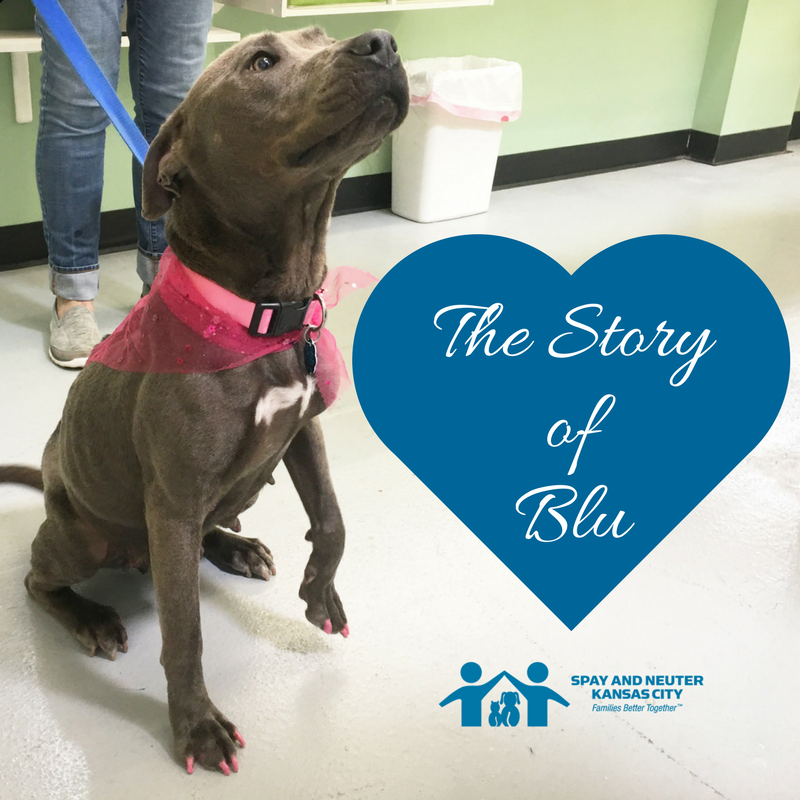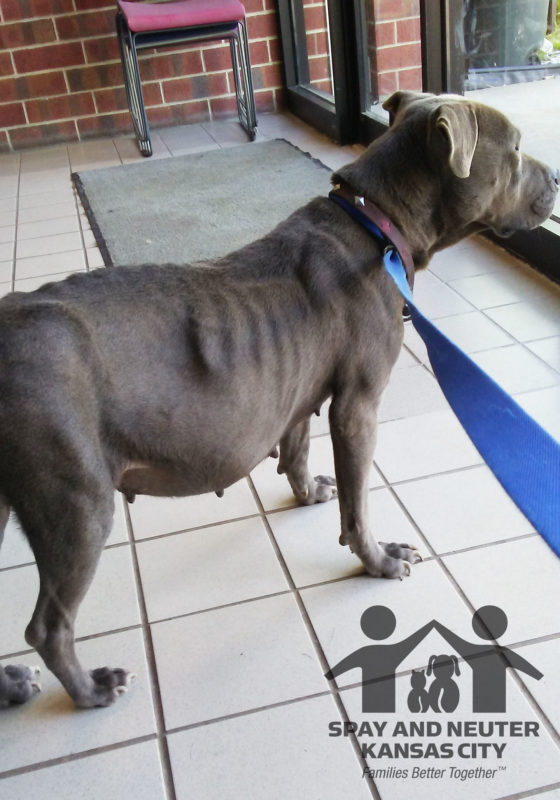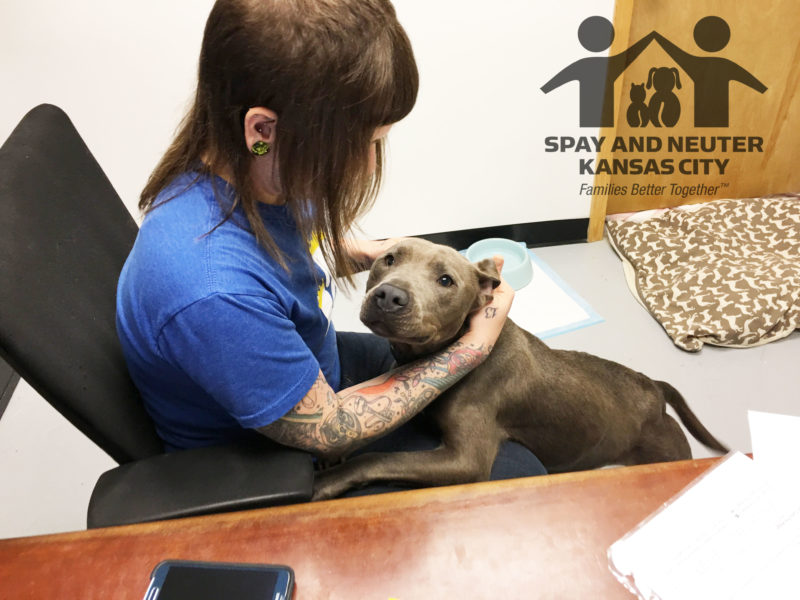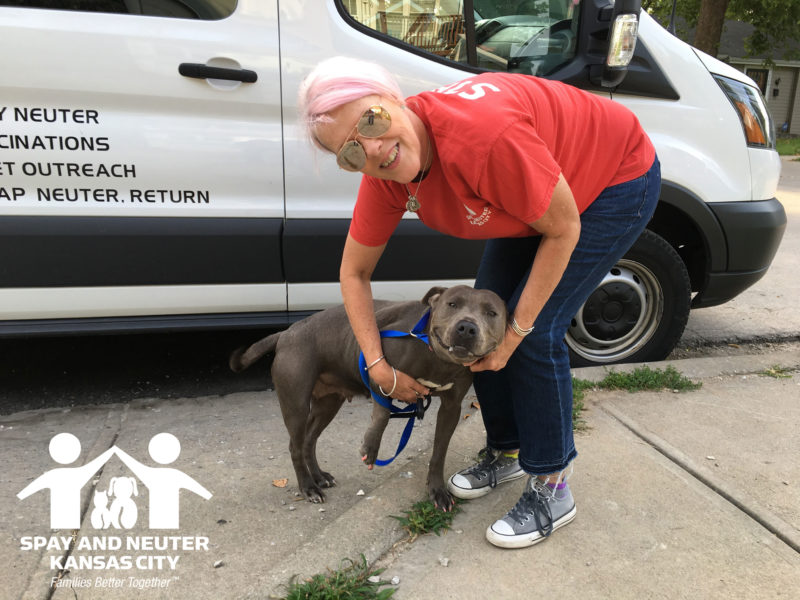
Beginnings
Blu’s owner, Mr. Nelson, got a ride to our KCMO clinic on a Tuesday morning in early May. He had questions about Blu. He thought she was pregnant; to the untrained eye, some of the symptoms were there. Her belly, at least, was huge. But this had been going on for three months now, and he was starting to get worried about her. She had a healthy appetite, he said. Wouldn’t stop eating, in fact. The staff member who was checking them in grabbed one of the vets, because the signs were all there: heartworms.
The heartworm test couldn’t have been any more positive if it had gotten up on the counter and danced.
For people in animal welfare, this can be the moment when things break down. All those efforts, the money raised, the flyers handed out, the off-site clinics held, the people we’ve been able to help, they just sort of recede into the background and we find ourselves asking: how did we get here? How did we fail?
We haven’t failed, though. It’s a difficult thing to remember: you can’t get to everybody. But it’s hard to look in the eyes of a pup like Blu and not feel the blame lies with you somehow, and with all of us. We have failed Blu by not being a society where people are educated on pet health and given access to resources to help them maintain the well-being of their companion. The only thing we can do is try to move forward and help out as best we can.
And that’s what we’ve done.
Heartworms, Companionship, and Treatment Plans
Heartworms, we explained, are transmitted by mosquitoes. A mosquito bites a heartworm positive dog, and takes heartworm microfilariae (a pre-larval stage of certain parasites) into itself as it feeds. The microfilariae develop into larvae, and when the mosquito bites another dog, it deposits the larvae into the dog’s bloodstream. They make their way to the heart, and now we have another heartworm positive dog.
Mr. Nelson was heartbroken. He loved her so much, and she’d been sick with something that was preventable, but he hadn’t even known to prevent it. He had no transportation, and in addition to that, he needed a kidney transplant and was going in for dialysis twice a week. His condition left him without a lot of time and energy to do what needed to be done. He didn’t have anybody to pick up the slack. It isn’t the type of thing we normally do, but somebody needed to step in and help.
The first thing we did is put out a call to our friends on social media. Heartworm treatment isn’t cheap, which all too often is the main obstacle to owners being able to get their furry family members treated. Some very kind donors stepped up and gave of themselves to help this little sweetie. This kind of fundraising is something we’re reluctant to do, sometimes, because there are no guarantees that the treatment would be effective or that Blu would survive the process. It feels strange to ask for money for uncertain situations, where the end result may be not be a positive one, and we try to be clear about that when it’s the case, because transparency is so important to us.
Once we had some funding to be able to move forward, the next step was developing a pre-treatment plan to get Blu ready. Wait, you’re saying; pre-treatment? Yep. Unfortunately, just because you want to treat a dog for heartworms doesn’t mean you’ll be able to. Depending on the severity of the situation and the overall health of the dog, their body may not be able to handle the treatment. This is Blu on the day we took her to get evaluated:

Her distended belly was from fluid retention. She’d lost a fair amount of muscle mass, too. It’s not the ideal state to begin heartworm treatment in.
So, for a while, Blu was here a lot. Families Better Together spent a lot of time with her. Everybody did, actually. We’d just bring her up to the clinic to hang out with us sometimes. We took her to our friends at The Grooming Project, who are responsible for the elegant look (including toenail painting!) that she’s sporting in the header image for this post. We’ve talked to too many people who’ve had to give up their dogs because they were in a similar situation. We knew these first few weeks were the most crucial, in a lot of ways. Why? We needed to get Blu to a place where she was a candidate for treatment. She’d retained a lot of fluid in her belly (as you can see in this pic), and that needed to go away to get a better picture of what was going on inside her. As is often the case with heartworm positive dogs, the initial treatment plan involved 3 drugs: Doxycycline, Furosemide, and Enalapril.
Doxycycline is an antibiotic; it weakens heartworms by killing an organism inside them that they depend on called Wolbachia. Furosemide helps with fluid retention. Enalapril, in this case, is used to ease the pressure on the heart; from a technical standpoint, it inhibits conversion of the peptide hormone Angiotensin I to Angiotensin II. The reason Angiotensin II is bad is because it restricts blood vessels, increasing blood pressure and the amount of work the heart has to do. So the pre-treatment plan boiled down to: get rid of that fluid, weaken the heartworms, and shore up that heart.
Mr. Nelson
While Blu was going through her pre-treatment, Mr. Nelson, after years of waiting, was finally put on the kidney transplant list, and found a perfect match almost immediately. We were thrilled for him, but that made things even more complicated: transplants are serious business, with rejection a constant possibility. He would have even less time, money, and energy to take care of Blu. He had his own pre- and post-operative care to focus on. He needed us now more than ever.
So we took it on ourselves to help out. Again, this is far beyond the scope of what we normally do. Unfortunately, we just don’t have the resources to help every heartworm-positive dog we come across, as much as we’d like to do just that. It just isn’t feasible.
Meanwhile, Blue was approved for heartworm treatment! She responded well to pre-treatment and was deemed a good candidate. And all the while, whether it was going to get pre-treatment or to go get a bath, as long as Blu was out and about, she was happy:

Moving Forward
So now the pre-treatment is done, and Blu is cleared for treatment, so it’s all easy stuff from here, right? Wrong; now the even harder part starts. It’s no joke when we tell people that a heartworm-positive diagnosis can often be a death sentence. The treatment is intensive from the get-go, and often requires weeks and weeks of keeping the dog as still and calm as possible. Why?
Well, treatment of heartworms is generally handled using injections of melarsomine. It’s incredibly important that the heartworms die slowly; if too many are killed at once, the dead worms can block the flow of blood, endangering the life of the dog. Exercise, even mild exercise, causes the heart to work harder, which can cause the worms to break apart more quickly, blocking blood vessels and causing stroke or sudden death. It’s serious business.
But try telling that to Blu. She’s always happy to see us, and always happy just to be around, honestly. She’s one of the sweetest, most trusting pups we’ve met in a long time, and we want to do everything we can to see that she’s around for a long time to come. How could we not? Look at that happy face!



